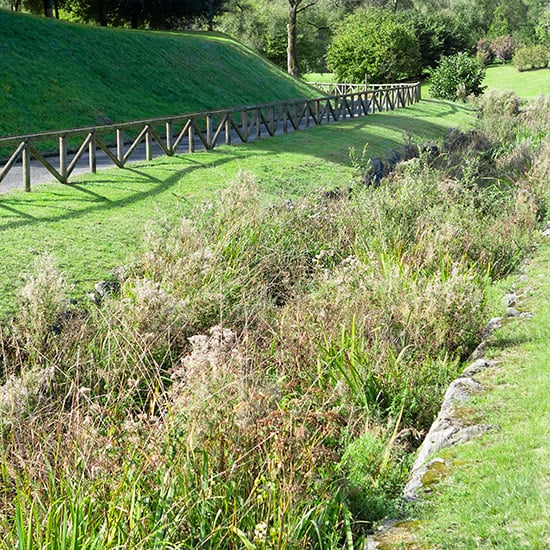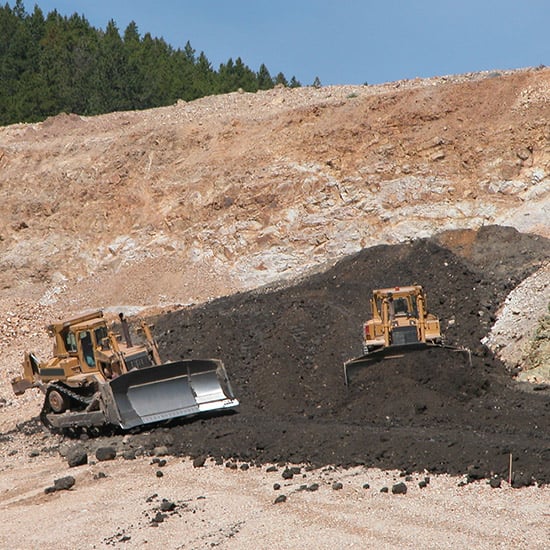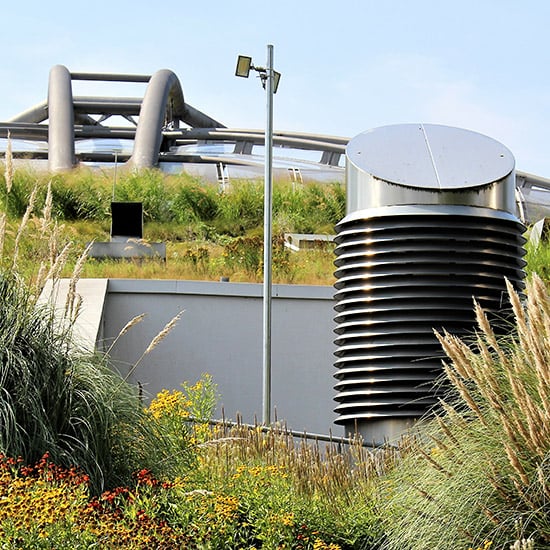
Greenscaping projects need enduring soil amendments, like pumice, that function in-soil indefinitely.
ENVIRONMENTAL APPLICATIONS OF PUMICE
The following physical and chemical character traits inherent in pumice provide a functional foundation for the performance of pumice as a soil amendment for engineered soils. Additional application-specific advantages are covered under the use-specific topics below.
ENDURING COMPONENT. A primary consideration for soil engineers is endurance. Returning every few years to recondition or rebuild the soil structure is rarely an option, so key structural and functional building blocks of the soil need to last indefinitely. Pumice, as a foamed glass stone, does not break down in soil. Nor does it float out over time and blow away. Once blended in, pumice remains an integral and functioning cog in the soil mix design. Compost, peat, or shredded organic by-products, by contrast, are often counted on to provide critical in-soil structure, and they do, until they don’t. Sooner rather than later, they are broken down and consumed.

Greenscaping projects need enduring soil amendments, like pumice, that function in-soil indefinitely.
LARGE-SCALE ECONOMICS. Soil amendment options are plentiful and economical for small-space situations, but for expansive landscaping projects, buying soil amendments by the bag is a budget buster. Better to bring in amendment by the ton and the truckload.
The always performing, foamed-stone class of light, water holding soil amendments come in two sub-classes: those calcined (expanded/popped) in a roaring furnace (like expanded perlite and expanded shales), or those calcined by nature in the fiery eruption of a volcano. The expansion process, of course, affects the price per ton. Pumice, being naturally calcined, needs only to be mined from the deposit and crushed to grade. Several of our mine grades (meaning no additional processing—drying, crushing, screening, grade-blending or testing—is necessary) are ideal for economically amending soils for large-scale projects.

Close-up images of the surface texture of pumice (left) and expanded perlite (right).
A PROVEN FORM-FACTOR. Expanded perlite is a popular and widely used non-compost amendment for building specialized soils—especially potting and garden soils. But the expansion-furnace process adds cost. Volcanically-calcined pumice is the physiochemical equivalent of expanded perlite and provides a cost-effective substitute without a performance drop. Their similar properties translate into similar behavior and performance in blended soil mixtures.
X-REF PERLITE VS. PUMICE
LIGHTWEIGHT. As a foamed glass stone, pumice provides its soil-amending properties at a lighter weight.
PARTICLE SIZE BLEND. The pumice mine grades used for soil amendments provide a good mixture of particle sizes, which do work on both a macro and micro level and provide a stable structural soil mix.
BLENDS READILY WITH COMPOST. Pumice can be blended with finished bulk compost to build a single-application product. As a matter of fact, blending pumice with the organic feedstock at the onset of the composting process provides several benefits during the composting process and results in a nutrient-enriched, dual-purpose amendment when composting is complete. Those benefits? Pumice provides a buffer to the extreme volatilization taking place in the decomposing matter, mitigates nitrogen loss, and provides inert bulking to improve airflow throughout the windrow.
X-REF IMPROVING THE COMPOSTING PROCESS WITH PUMICE
The keys to amending poor native soils in these types of large-area greenscaping constructs are performance, longevity and cost. Pumice checks all those boxes.

The soils beneath urban parks need to resist compaction under use. Pumice will open heavy, platey clay soils, resist re-compaction, and help keep the root zone fully functional.
Traffic-bearing Soils
Using mechanical tillage to restore tilth and reopen the root zone for new crops in poorly structured soils is viable for annual replacement growing, but for greenscaping and landscaping applications, the rip-and-fluff approach is not an option. Add traffic of any kind to the use profile of a landscaping feature—turf-field applications, urban parks, or drainage-enhanced paver hardscapes that are designed to attract and support traffic—and compaction accelerates, quickly destroying the functional health of the root zone.
The solutions include trucking in suitable topsoil to replace the poor stuff, trucking in pre-blended engineered soil, or blending structure-improving amendments directly into the native soil to resist compaction forces. As a component in soil mix design, pumice checks the boxes in terms of functional longevity, large-scale use economics, compost compatibility, and its nutrient-and-water-holding form factor.

This healthy bioswale captures, treats, and infiltrates stormwater runoff. Pumice adds an aggressive filtration element while facilitating and enhancing drainage through the supporting soil.
Biofiltration Structures
The foamed-stone character of pumice—extensive surface area, neutral pH, and irregular, porous, sponge-like surface texture—makes it and ideal fit for stormwater filtration applications, whether blended into specially-designed runoff filtration soil constructs or as a functional component in a catch basin filter media. Specifications vary from state to state and structure to structure, but the myriad biting edges on a pumice make it an aggressive filtering component for almost any mix design. The combination of filtration performance, root zone-health-boosting benefits, soil biota support, drainage enhancement, and an economical price point, makes pumice is a great fit for biofiltration structures.
MICROBE COLONY SCAFFOLDING. The nook-and-cranny riven surface of every tiny pumice stone provides a stable structure for colonies of beneficial soil microbes, including those that consume organic pollutants.

Stockpiled or trucked-in topsoil, especially if a poorly-structured native soil, can be performance-boosted with pumice to enhance drainage, mitigate runoff, and rebuild tilth. Compost will recharge the soil nutrients and microbial life. Pumice-blended compost provides the newly-seeded plant cover with a significantly better chance to not only survive, but to thrive.
Construction Damage and Mining Reclamation
Soil reclamation projects, spurred by damage from construction or industrial activities, all share a common goal: rebuild the topsoil to a viable, growth-sustaining state. Nutrients and beneficial microbes must be replaced (even stockpiled topsoils suffer from mycorrhizae die-off in as little as eight months). A functional and enduring structure must be rebuilt in the root zone so thriving vegetative cover can be reestablished.
When done right, the reconditioned soil stays loose and friable in the root zone, allowing the critical exchange of gases—respiration—to occur freely. Improved Cation Exchange Capacity (CEC) holds nutrients, making them available to crops, turf grasses or native ground cover over a longer span. Drainage is optimized from improved infiltration, mitigating runoff and erosion problems. Moisture requirements—duration and frequency—go down. Contaminated runoff water is aggressively filtered. Turf grasses thrive, self-seeding native plant yields increase, and overall vegetative success is improved.
The high failure rates of native seeding operations for many reclamation projects can be blamed on poor or nonexistent rebuilding of the soil profile. The failure rate is especially acute when working with marginal topsoils—once disturbed and mixed with sterile subsoils, the chance of viable supporting plant cover is severely compromised. In properly structured soils, a dose of compost and/or hydroseeding nutrients may be enough. In poor soils, the desired profile must be rebuilt. A liberal dose of amendment-grade pumice blended to the top six or so inches of the soil will figure prominently in getting the performance profile and functional mechanics right.
Bioremediation of Contaminated Sites
Rehabilitating damaged and contaminated sites reduces the pressure on undeveloped lands and reclaims valuable real estate. Using micro-organisms in situ to consume and/or breakdown pollutants in soils calls for ideal soil conditions that meet the particular needs of the microbes doing the work. Pumice, with it foamed-stone form factor, provides scaffolding for the microbe colonies, retains moisture, facilitates drainage, opens soil pore spaces to improve gas exchange and more. Pumice can even be precharged with fertilizing nutrients for biostimulation strategies.
LARGE-SCALE ECONOMICS. Naturally calcined and available by the ton (mine grades), pumice is the cost effective choice over kiln-expanded clays, shales, and slates for large soil amendment projects.

Pumice works as a frothy, enduring, structure-shaping component of lightweight engineered soils, like those formulated for green roof planting beds.
Greenroofs and similar elevated planting structures require a grow media that sits light and easy, yet provides a low-maintenance, highly-functional foundation for thriving vegetation. That means an engineered soil tailored for the unique demands of the project.
LIGHTWEIGHT COMPONENT. Pumice provides a lightweight soil particle—a frothy, foamy mineral that facilitates drainage while retaining moisture and nutrients for plant uptake, forms and holds open soil pore spaces for a healthy, breathable root zone, and provides an enduring scaffolding for colonies of thriving soil microbes.
GRADE BLENDED. High-performance soils contain a variety of particle sizes, which is vital to the formation of diverse void spaces and structural stability within the soil matrix. Hess soil amendment grades are grade-blended, with a top size designation (1/8 or 3/8) and a grade curve that sweeps down to the smallest fines. Plus, the in-soil performance provided by pumice is functional across the entire grade curve. One of the key characteristics of pumice is its processed friability, meaning even the tiny fines retain the sponge-like structure and grippy surface topography that make pumice so widely useful.
NEUTRAL pH + NATURAL PURITY. Our pumice is pH-neutral, so no compensation is needed in the soil mix design. And, as the result of centuries of relentless wave action, the Hess pumice deposit is naturally pure—washed free of heavy metals, salts, and other contaminates.
Pumice is used as a lightweight aggregate in insulative concrete mixes, and the same lightweight form factor that makes pumice work in concrete allows it to perform as a lightweight geotechnical fill. Pumice is light, strong, enduring, stable, insulative, and chemically inert. It will not break down under UV or solvent attack and is available in several economical mine grades. Placement and compaction to be determined by the project engineer.

Long-lived curated landscapes and special-use parks, like this natural turf sports field, require a base of carefully engineered soil.
Contact Us
Research and Development
208-766-4777 x111
• • •
Product Sales
(208) 766-4777 x138